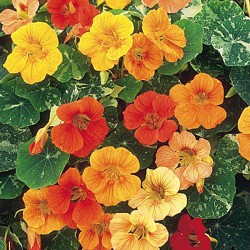



Nasturtium Seeds Jewel Mix produce bright flowers throughout the summer. A great ground-cover and popular in hanging baskets too.
Nasturtiums (Tropaeolum majus) are not only easy to grow from seeds and pretty to look at, they are hard-working, edible flowers that more than earn their spot in any home garden. These cheerful little annuals flowers thrive on neglect and will work hard for you both above and below the soil level without needing anything in return. There’s an old adage that applies to these growing annuals flowers - be nasty to nasturtiums. Use these nasturtium growing tips and get ready to enjoy a colorful bloom harvest and improved garden soil structure by growing nasturtiums.
See also our other nasturtium seeds:
- Nasturtium Tall Climbing mix seeds
- Nasturtium Tom Thumb Alaska mix seeds
- Nasturtium Bloody Mary Seeds
- Nasturtium Whirlybird mix seeds
Nasturtiums are hardy annuals and not picky about the soil in which they grow. Select any sunny location to plant these hard working annuals. They will grow in partial shade too, but will not produce many flowers so they much prefer full sun. Nasturtium seeds can be planted directly into the garden where they are to grow you do not have to sow them in pots and plant out later.
A light tilling to break-up the top soil is the only soil preparation needed prior to planting. Do not work in organic matter or fertilize as this will actually cause the plants to produce fewer blooms.
When planning to plant nasturtiums in the vegetable garden as a companion plant, try to limit the usage of organic matter in the areas where the flowers will be planted.
The seeds are large and have a hard exterior shell, for faster germination, soak the seed in warm water overnight prior to planting.
Seeds can be started indoors in a flat container or pots 6 weeks before the last spring frost in your region. Seedlings can be transplanted into the soil once the plants have developed their second set of leaves, called true leaves, and all danger of frost has past. Space plants 12 inches apart. The plants grow rapidly and will fill in all the gaps very quickly.
If you prefer to plant seeds directly into outdoor soil, wait until all danger of frost has past. Sow seeds into prepared soil, then cover with 1/2 inch of soil and water in well. Thin plants to 12 inches apart by plucking the extras ones out of the soil after the seeds germinate.
Nasturtiums will germinate and plants will be visible in 7-10 days. Keep soil moist, but not soggy, at all times during the germination process.
The mature size of nasturtiums depends on the variety planted, Dwarf varieties will make a compact mound of about 15 inches tall and climbing varieties can reach over 10 feet in vine length. Dwarf varieties can be grown as outdoor potted plants and as a ground cover plant, mounding varieties make perfect edging/border plants and climbing varieties will need a trellis or other structure on which to climb on for best results.
The plants are fast growing and begin to bloom in late spring and will continue producing until the first killing frost of fall. Blooms are funnel-shaped and have single, semi-double and double flower petals. Blooms colours are bright yellow, red, salmon, apricot, peach and cream.
The abundant and colorful nasturtium flowers are irresistible to hoverflies and butterflies. You will have constant flying visitors to the nasturtium plants all summer. The blooms also makes nice cut flowers for you to enjoy in a fresh floral arrangement.
Only water during times of drought and never feed the plants.
Deadhead spent blooms to keep the plants producing new bloom throughout the summer. When grown as a potted plant, nasturtiums may need to be cut back by mid-summer to keep them looking neat. The plants will bounce back after a severe pruning, so you don’t have to go easy on them.
The flowers and leaves of nasturtiums are edible and rich in vitamin C. Both the leaves and blooms have a peppery flavour. Most often the leaves are used as part of a green salad and the blooms are used as plate garnish, and they also make a great ingredient to use to create flavoured vinegar.
Nasturtiums are a natural pest repellent and will protect garden vegetables from harmful pests when planted as a companion plant. These colourful flowers will repel aphids, squash bugs and cucumber beetles so they won’t start home steading in your home garden and devour your plants.
The roots of nasturtiums also increase the nitrogen level in garden soil and help to improve plant growth by strengthening plant roots. This hard working annual is a must have in an organic vegetable garden for both pest control and soil amending.
The nasturtium plants will develop their own flower seeds pods, after the flowers are spent, but they are not a self-seeding plant although in a mild winter it can happen to nasturtiums too.
Harvest the seed pods and spread them out in a single layer in a warm, dry place for the winter. Come spring, and if you want to grow nasturtiums again, you will have your own nasturtium seeds to plant and save yourself a little money.
.